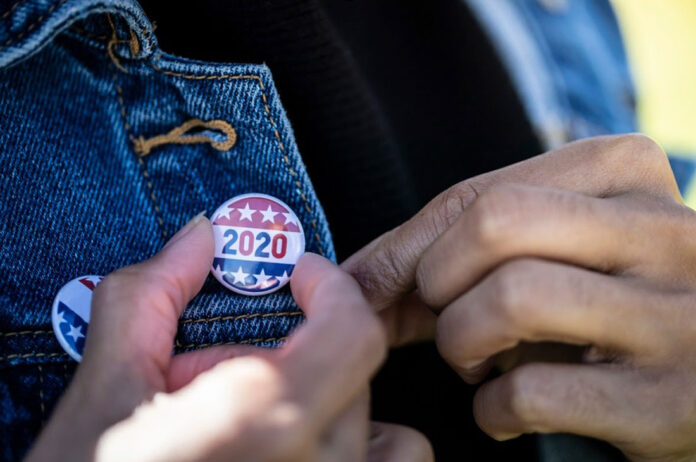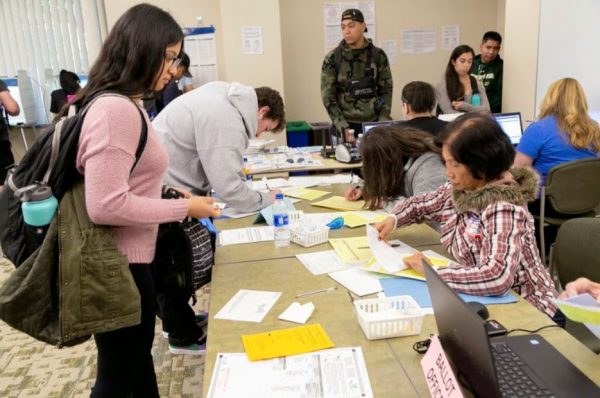
By Bella Ross, CALMatters
First-time voter Fernando Villarreal is looking forward to participating in the upcoming presidential election.
“I think it’s a really important election for democracy and I think young people have a lot at stake when it comes to education, healthcare and a lot of other issues,” said the Palomar College freshman.
But that doesn’t mean the process is straightforward for Villarreal, who registered to vote just a few months ago while applying for a business license for an apparel company he recently launched. Since then, he hasn’t crossed paths with any voter outreach efforts, but he did have a few questions: What should he do with his mail-in ballot once he fills it out? And how to make sense of the state’s propositions, which he called “confusing”?
“For the mail-in ballots you have to sign it on the back, and if you don’t sign it I guess your vote is tossed out or it’s just not valid, and it’s a really small box on the back,” he said. “I think it should be simpler.”
California has seen an increase of 24% in youth voter registration compared to the last presidential election in November 2016.
Driven by concerns about climate change, racism and healthcare, students are more mobilized around the November election than they were in 2018 or 2016, researchers who study the group’s voting patterns say. But the coronavirus pandemic has also exacerbated a lack of information among younger Californians about where and how to vote. Student get-out-the-vote organizers are trying to close that gap, trading tabling for social media campaigns as they work to reach their peers who are scattered and isolated by the pandemic.

Whereas 33% of 18 to 24 year olds tried to convince other young people to vote in 2018, that number increased to 50% for this election, according to a poll conducted by Circle, a research center at Tufts University focused on youth civic engagement. Most states have also seen an increase in youth voter registration when compared to November 2016, the last presidential election, including a 24% increase in California.
And while older voters are more likely to vote early than younger ones, more than a million voters 18-29 have already cast ballots nationwide, according to the Democratic data firm TargetSmart, up from 266,000 at this point in 2016.
“There definitely are promising signs for youth engagement, and we expect to see high youth engagement, but there are also these real barriers that I think young people and groups who support them are actively working against,” said Circle’s research program coordinator, Peter de Guzman.
Among college students in particular, many are first-time voters, unfamiliar with the voting process or likely to be living at an address other than the one where they initially registered. De Guzman said these kinds of barriers play a more significant role in non-voting than political apathy.
“We’ve seen that young people needed somebody to arrange their work or school schedule, a lot of them did not know where to vote, people needed to arrange rides to the polls, so there’s those barriers,” De Guzman said. “I would say, overall, what we see is they’re not barriers of apathy or not caring, but more barriers of access.”
The pandemic has added new hurdles. States are attempting to carry out widespread mail-in voting. College campuses have emerged as hotspots for the virus, meaning the lives of students are more in flux than ever.
“I would say, overall, what we see is they’re not barriers of apathy or not caring, but more barriers of access.”
PETER DE GUZMAN, CIRCLE’S RESEARCH PROGRAM COORDINATOR
By clicking subscribe, you agree to share your email address with CalMatters to receive marketing, updates, and other emails from the site owner. Use the unsubscribe link in those emails to opt out at any time.
Voter registration efforts were once nearly inescapable on college campuses during the months before the election. But with campus walkways emptied since March, there is no more tabling outside the library, and there is no more free pizza to be enjoyed at in-person registration drives.
“This year, we went from knocking on doors to pounding on keyboards,” said Jesse Barba, senior director of external affairs for the youth outreach organization Young Invincibles.
Students who registered to vote at campus events during prior elections are likely to have used a school address, but are unlikely to be living at that same address during the pandemic, said Lisette Mata, Deputy Secretary of State for Operations in the California Secretary of State’s office.
“Now that many of them are living back at home, they may not realize that they need to update their registration because their ballot and information is going to be sent to the address that they used to register at that event with a student organization,” Mata said.
One easy way students could update their registration in the last election was by visiting a vote center — a one-stop shop that opens several days before Election Day, where people can cast ballots, update their voter registration or access other voting resources. The first on-campus vote center in California opened at Sacramento State in 2018, and the Secretary of State was working with county registrars to dramatically expand the number of campuses with them this year. A state law passed last year encouraged registrars to locate the centers at colleges.
Sacramento State students vote on campus, November 6, 2018. Photo by Eucario Calderon, The State Hornet
But COVID-19 has cut across those plans as colleges host fewer students on-campus and restrict in-person activities.
“A lot of students are saying that their administrators pulled back the decision to have a vote center or a polling location, or they were just confused and stalled,” Mata said.
She said elections are considered a critical function that are allowed to operate at schools despite campus closures, but many administrators don’t know that.
Some more active campus communities, such as UCLA, still plan to provide these spaces. Even in a pandemic, students and community members still depend on them, Mata said. But others, like Grossmont College in San Diego, opted not to have a vote center on campus due to health and safety concerns.
The community college’s student government originally wanted to have a vote center despite the concerns of administrators, said Cadence Dobias, a Grossmont student and board member of the Student Senate for California Community Colleges. But once it became clear COVID-19 cases in the area were worsening, they agreed the in-person center could put students at risk.
“A lot of students are saying that their administrators pulled back the decision to have a vote center or a polling location, or they were just confused and stalled.”
LISETTE MATA, CALIFORNIA SECRETARY OF STATE’S OFFICE
With limited chances to talk in person, student organizers say they’re instead starting voting-focused social media accounts, making announcements at the end of Zoom lectures and calling up unregistered peers.
“We redeveloped our website, we began to develop a Rock the Vote Instagram account, we looked into creating digital events and experiences, and we’re trying to figure out ways we can motivate students to come and register to vote,” said Armando Sepulveda, Rock the Vote chair at San Diego State University.
One adaptation Sepulveda noted was the need to offer voter registration guidelines for all 50 states, rather than for just California, in order to accommodate out-of-state students.
At UCLA, organizers with CALPIRG are using personal connections to make a good first impression, senior and CALPIRG Statewide Board Chair Nic Riani said.
“Instead of tabling, which we did in the past … we’ll be doing friend-to-friend outreach, calling and texting our friends to make sure they’re registered,” Riani said. “It’s really the same general approach, but just some of the tactics have changed.”
The tactics used in voter mobilization efforts also greatly depend on the demographics of each campus. Dobias, from Grossmont College, said community colleges may face unique barriers based on the varying backgrounds of their students.
“From having multiple different campus locations to varying schedules, with day classes and night classes and those being very different demographics,” Dobias said. “It was already a struggle to engage our students and now it’s entirely different.”
For one, she said reaching students in online spaces leaves out those who have less access to technology, or less knowledge about how to use it. Even among those who have access to technology, finding a safe space to vote can be a struggle.
“During this time, we had to take into consideration that some students aren’t being provided the spaces like our library and student services and bookstore where they can have a safe space to do their work and fill out forms, without maybe any of the pressures going on in their home life,” Dobias said.
“Even if they don’t feel like their vote matters in the presidential election, it could shape the change in a school board, in a city council or even in a congressional seat.”
ARMANDO SEPULVEDA, ROCK THE VOTE CHAIR AT SAN DIEGO STATE UNIVERSITY
For those who can’t vote due to their citizenship status or former incarceration, Dobias said it is important to remind these students there are other ways to be politically engaged beyond just election season. This may include talking to family and friends about the issues that are important to them, and encouraging them to vote as if they are doing so on their behalf.
“We want to engage these students beyond just voting,” she said. “We want to make them social and political advocates for what they’re passionate about.”
California will almost certainly vote blue in the presidential race, like it has in every election since 1992. But increased voting among young people — who tend to be left-of-center — could impact outcomes at the state and local level.
“Even if they don’t feel like their vote matters in the presidential election, it could shape the change in a school board, in a city council or even in a congressional seat,” Sepulveda said. “It is up to us to protect our democracy and the best way to do that is to participate.”
One state proposition that is likely to resonate with college students is Proposition 16, under which voters will determine whether colleges within the state may implement affirmative action based on race, gender or ethnicity in admissions and hiring. The ballot measure is polling poorly, but student associations at the University of California and the California Community Colleges have endorsed it, along with the governing boards of those systems and the California State University.
Barba, from Young Invincibles, said the pandemic has more young people thinking about health care and the cost of higher education.
However, the full list of issues that are likely to inspire young voters is vast, said De Guzman from Circle.
“We also see differences by race of young people and the issues they care about,” he said. “It really just shows that young people are not a monolith.”
Voters may register in-person until Nov. 3. Rules and registration deadlines vary by state.


